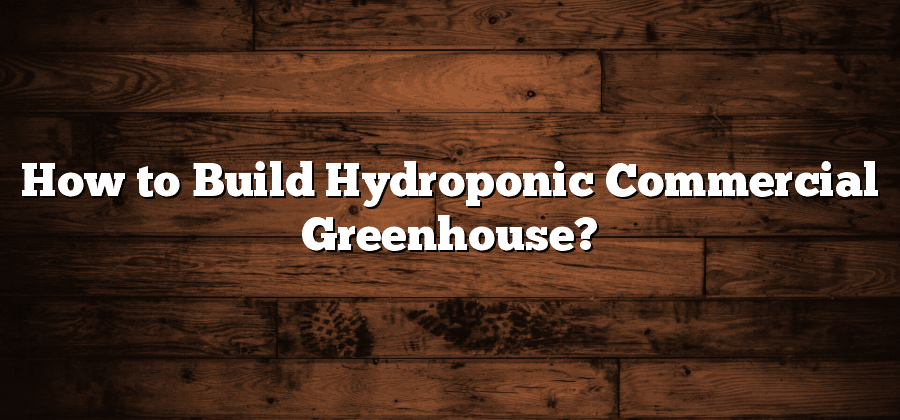Selecting the Ideal Location for Your Hydroponic Greenhouse
Selecting the ideal location for your hydroponic greenhouse is a crucial step in ensuring its success. There are several factors to consider in order to make an informed decision. Firstly, you need to assess the amount of sunlight the location receives throughout the year. Since hydroponic plants rely heavily on artificial lighting, it is essential to choose a spot with ample natural sunlight to supplement the supplemental lighting. Additionally, it is important to consider the proximity of your greenhouse to a water source. As hydroponic systems require constant access to water, it is convenient to have a water supply nearby to minimize potential difficulties in irrigation.
Moreover, you should carefully assess the environmental conditions of the location. Optimal temperature ranges are vital for the healthy growth of hydroponic crops, so it is crucial to choose a spot where the temperature can be easily controlled and maintained. Furthermore, it is important to consider the proximity to markets or potential customers. Selecting a location closer to your target market can reduce transportation costs and ensure fresher produce for your customers. Lastly, it is important to research and comply with any zoning regulations and building codes in your area to avoid any legal complications. By considering these factors, you can select an ideal location for your hydroponic greenhouse that maximizes productivity and efficiency.
Designing the Layout and Structure of Your Commercial Greenhouse
Once you have selected the ideal location for your hydroponic greenhouse, the next step is to focus on designing the layout and structure of the greenhouse. This is a crucial aspect as it will determine the efficiency and productivity of your commercial greenhouse operation.
When designing the layout, it is important to consider factors such as space utilization, ease of movement, and accessibility to all the plants. You need to plan the arrangement of the growing trays or beds, ensuring that each plant receives sufficient space and light. Additionally, you should also consider the placement of irrigation systems and other equipment to ensure easy access for maintenance and monitoring.
Next, you need to pay attention to the structure of the greenhouse. The materials used should be durable, weather resistant, and able to withstand the weight of the plants, equipment, and environmental challenges. Proper ventilation and insulation are also key considerations in order to maintain optimal growing conditions inside the greenhouse. Additionally, you should plan for adequate drainage to prevent waterlogging and ensure proper circulation.
Designing the layout and structure of your commercial greenhouse may require the assistance of professionals or experts in the field. Their knowledge and experience can help ensure that your greenhouse is well-designed and equipped to support healthy plant growth and maximize your overall yield.
Ensuring Proper Ventilation and Air Circulation in Your Hydroponic Greenhouse
Proper ventilation and air circulation are crucial factors to consider when setting up a hydroponic greenhouse. Ensuring a well-ventilated growing environment helps to maintain optimal temperature and humidity levels, as well as prevent the buildup of harmful gases and pathogens. Additionally, adequate air circulation promotes the even distribution of carbon dioxide and nutrients among the plants, enhancing their overall growth and productivity.
One effective method for achieving proper ventilation is through the use of exhaust fans and intake vents. Exhaust fans are strategically positioned to expel stale air and excess moisture from the greenhouse, while intake vents allow fresh air to enter. By installing these ventilation systems, growers can control the temperature and humidity inside the greenhouse, ensuring that it remains suitable for the plants’ growth.
Choosing the Right Hydroponic System for Your Commercial Greenhouse
When it comes to selecting the right hydroponic system for your commercial greenhouse, there are several factors to consider. First and foremost, you need to determine the type of crops you will be growing. Different crops have different nutrient requirements, and certain hydroponic systems may be better suited for specific crops. It is important to research and understand the nutritional needs of your chosen crops before making a decision.
Another crucial factor to consider is the size of your greenhouse. The size will determine the capacity of the hydroponic system you need. If you have a large greenhouse, you may opt for a larger-scale system that can accommodate a higher volume of plants. On the other hand, if you have a smaller greenhouse, a more compact system may be sufficient. It is essential to assess your space limitations and choose a hydroponic system that fits your greenhouse perfectly.
Selecting the Appropriate Lighting System for Your Hydroponic Greenhouse
When it comes to selecting the appropriate lighting system for your hydroponic greenhouse, there are several factors to consider. The first consideration is the type of crops you will be growing and their specific lighting requirements. Different plants have different light intensity and duration needs, so it is important to choose a lighting system that can deliver the right amount of light for optimal growth.
Another important factor to consider is the efficiency and energy consumption of the lighting system. LED lights are more commonly used in hydroponic greenhouses due to their energy-saving benefits and long lifespan. These lights emit less heat, reducing the risk of overheating and minimizing the need for additional cooling systems. Additionally, LED lights can be customized to provide specific spectrum wavelengths that cater to the needs of different plant growth stages.
In conclusion, selecting the appropriate lighting system for your hydroponic greenhouse requires careful consideration of your crops’ lighting requirements and energy efficiency. LED lights are a popular choice due to their customizable spectrum, energy-saving features, and long lifespan. By choosing the right lighting system, you can ensure optimal growth and yield for your hydroponic crops.






